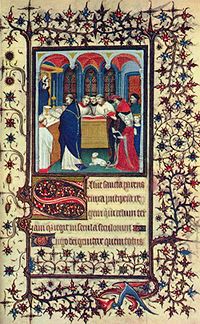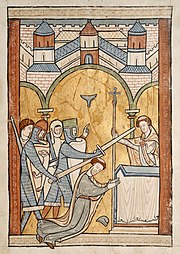Illuminated manuscript
From Wikipedia, the free encyclopedia

An illuminated manuscript is a manuscript in which the text is supplemented by the addition of decoration, such as decorated initials, borders and miniature illustrations. In the strictest definition of the term, an illuminated manuscript only refers to manuscripts decorated with gold or silver. However, in both common usage and modern scholarship, the term is now used to refer to any decorated or illustrated manuscript from the Western or Islamic traditions. Comparable Far Eastern works are always described as painted, as often are Islamic and Mesoamerican works.
The earliest surviving substantive illuminated manuscripts are from the period AD 400 to 600 (also in the gothic period), primarily produced in Ireland, Constantinople and Italy. The significance of these works lies not only in their inherent art history value, but in the maintenance of a link of literacy offered by non-illuminated texts as well. Had it not been for the monastic scribes of Late Antiquity, the entire literature of Greece and Rome would have perished; as it was, the patterns of textual survivals were shaped by their usefulness to the severely constricted literate group of Christians. The very existence of illuminated manuscripts as a way of giving stature and commemoration to ancient documents may have been largely responsible for their preservation in an era when barbarian hordes had overrun continental Europe and ruling classes were no longer literate.
The majority of surviving manuscripts are from the Middle Ages, although many illuminated manuscripts survive from the 15th century Renaissance, along with a very limited number from Late Antiquity. The majority of these manuscripts are of a religious nature. However, especially from the 13th century onward, an increasing number of secular texts were illuminated. Most illuminated manuscripts were created as codices, which had superseded scrolls; some isolated single sheets survive. A very few illuminated manuscript fragments survive on papyrus. Most medieval manuscripts, illuminated or not, were written on parchment (most commonly of calf, sheep, or goat skin), but most manuscripts important enough to illuminate were written on the best quality of parchment, called vellum, traditionally made of unsplit calf skin, though high quality parchment from other skins was also called parchment.
Beginning in the late Middle Ages manuscripts began to be produced on paper.[1] Very early printed books were sometimes produced with spaces left for rubrics and miniatures, or were given illuminated initials, or decorations in the margin, but the introduction of printing rapidly led to the decline of illumination. Illuminated manuscripts continued to be produced in the early 16th century, but in much smaller numbers, mostly for the very wealthy.

Illuminated manuscripts are the most common item to survive from the Middle Ages.[citation needed] They are also the best surviving specimens of medieval painting, and the best preserved. Indeed, for many areas and time periods, they are the only surviving examples of painting.
For a list of illuminated manuscripts see list of illuminated manuscripts.
Contents |
[edit] History
[edit] Techniques
Illumination was a complex and frequently costly process. It was usually reserved for special books: an altar Bible, for example. Wealthy people often had richly illuminated "books of hours" made, which set down prayers appropriate for various times in the liturgical day.
In the early Middle Ages, most books were produced in monasteries, whether for their own use, for presentation, or for a commission. However, commercial scriptoria grew up in large cities, especially Paris, and in Italy and the Netherlands, and by the late fourteenth century there was a significant industry producing manuscripts, including agents who would take long-distance commissions, with details of the heraldry of the buyer and the saints of personal interest to him (for the calendar of a Book of hours). By the end of the period, many of the painters were women, perhaps especially in Paris.
[edit] Text
In the making of an illuminated manuscript, the text was usually written first. Sheets of parchment or vellum, animal hides specially prepared for writing, were cut down to the appropriate size. After the general layout of the page was planned (e.g., initial capital, borders), the page was lightly ruled with a pointed stick, and the scribe went to work with ink-pot and either sharpened quill feather or reed pen.
The script depended on local customs and tastes. The sturdy Roman letters of the early Middle Ages gradually gave way to scripts such as Uncial and half-Uncial, especially in the British Isles, where distinctive scripts such as insular majuscule and insular minuscule developed. Stocky, richly textured blackletter was first seen around the 13th century and was particularly popular in the later Middle Ages. Palaeography is the study of historical handwritten scripts, and codicology the related study of other physical aspects of manuscript codexes.
[edit] Classifications
Art historians classify illuminated manuscripts into their historic periods and types, including (but not limited to): Late Antique, Insular, Carolingian manuscripts, Ottonian manuscripts, Romanesque manuscripts, Gothic manuscripts, and Renaissance manuscripts. There are a few examples from later periods. The type of book that was most often heavily and richly illuminated, sometimes known as a "display-book", varied between periods. In the first millennium these were most likely to be Gospel Books. The Romanesque period saw the creation of many huge illuminated complete Bibles - one in Sweden requires three librarians to lift it. Many Psalters were also heavily illuminated in both this and the Gothic period. Finally, the Book of Hours, very commonly the personal devotional book of a wealthy layperson, was often richly illuminated in the Gothic period. Other books, both liturgical and not, continued to be illuminated at all periods. The Byzantine world also continued to produce manuscripts in its own style, versions of which spread to other Orthodox and Eastern Christian areas. See Medieval art for other regions, periods and types.
The Gothic period, which generally saw an increase in the production of these beautiful artifacts, also saw more secular works such as chronicles and works of literature illuminated. Wealthy people began to build up personal libraries; Philip the Bold, Duke of Burgundy, who probably had the largest personal library of his time in the mid-15th century, is estimated to have had about 600 illuminated manuscripts, whilst a number of his friends and relations had several dozen.
[edit] Images

When the text was complete, the illustrator set to work. Complex designs were planned out beforehand, probably on wax tablets, the sketch pad of the era. The design was then traced or drawn onto the vellum (possibly with the aid of pinpricks or other markings, as in the case of the Lindisfarne Gospels). Many incomplete manuscripts survive from most periods, giving us a good idea of working methods.
At all times, most manuscripts did not have images in them. In the early Middle Ages, manuscripts tend to either be display books with very full illumination, or manuscripts for study with at most a few decorated initials. By the Romanesque period many more manuscripts had decorated or historiated initials, and manuscripts essentially for study often contained some images, often not in colour. This trend intensified in the Gothic period, when most manuscripts had at least decorative flourishes in places, and a much larger proportion had images of some sort. Display books of the Gothic period in particular had very elaborate decorated borders of foliate patterns, often with small drolleries. A Gothic page might contain several areas and types of decoration: a miniature in a frame, a historiated initial beginning a passage of text, and a border with drolleries. Often different artists worked on the different parts of the decoration.
[edit] Paints
The medieval artist's palette was surprisingly broad. In addition to the substances listed below, unlikely-sounding substances such as urine and earwax were used to prepare pigments[2].
| Colour | Source(s) |
|---|---|
| Red | Mercury(II) sulfide (HgS), often called cinnabar or vermilion, in its natural mineral form or synthesized; "red lead" or minium (Pb3O4); insect-based colours such as cochineal, kermes and lac; rust (iron oxide, Fe2O3) or iron oxide-rich earth compounds |
| Yellow | Plant-based colours, such as Weld, turmeric or saffron; yellow earth colours (ochre); orpiment (arsenic sulfide, As2S3) |
| Green | Plant-based compounds such as buckthorn berries; copper compounds such as verdigris and malachite |
| Blue | Ultramarine (made from the rock lapis lazuli) or azurite; smalt; plant-based substances such as woad, indigo, and folium or turnsole |
| White | Lead white (also called "flake white", basic lead carbonate (PbCO3)); chalk |
| Black | Carbon, from sources such as lampblack, charcoal, or burnt bones or ivory; sepia; iron and gall |
| Gold | Gold, in leaf form (hammered extremely thin) or powdered and bound in gum arabic or egg (called "shell gold") |
| Silver | Silver, either silver leaf or powdered, as with gold; tin leaf |
[edit] Gallery
|
An illuminated capital letter P in a Bible of A.D. 1407, Malmesbury Abbey, Wiltshire, England |
The illuminated letter P in the Malmesbury Bible. The script is blackletter, also known as Gothic script |
Armenian manuscript of 1053. Work of Johannes. |
|
|
The Book of Dimma, an 8th century Irish pocket Gospel Book. |
Saint Bernard of Clairvaux, in a medieval illuminated manuscript. |
[edit] See also
- List of illuminated manuscripts
- Manuscript culture
- List of Hiberno-Saxon illustrated manuscripts
- Gospel Book
- English Apocalypse Manuscripts
- Armenian Illuminated manuscripts
- History of the book
- Preservation of Illuminated Manuscripts
- Anastasia (flourished c 1400, Paris) was a French illuminator of manuscripts.
[edit] References
- ^ The untypically early 11th century Missal of Silos is from Spain, near to Muslim paper-mills in Al-Andaluz. Textual manuscripts on paper become increasingly common, but the more expensive parchment was mostly used for illuminated manuscripts until the end of the period.
- ^ Iberian manuscripts (pigments)
[edit] External links
[edit] Images (mostly)
- Medieval Illuminated Manuscipts Digitized illuminated manuscripts from the Dutch Royal Library
- Museum of the Book, The Hague. Thematic introduction, with many examples illustrated
- Project from Cambridge University - coloured numbers are links to good images from various collections; good for finding images of specific subjects quickly
- Illuminated Manuscripts in the J. Paul Getty Museum - Los Angeles
- Portal to manuscripts in French public collectiuons huge databases, in French
- Illuminating the Manuscript Leaves Digitized illuminated manuscripts from the University of Louisville Libraries
[edit] Resources
| Wikimedia Commons has media related to: Illuminated manuscripts |
- British Library, catalogue of illuminated manuscripts
- Collection of illuminated manuscripts. From the Koninklijke Bibliotheek and Museum Meermanno-Westreenianum in The Hague.
- On-line demonstration of the production of an illuminated manuscript from the Fitzwilliam, Cambridge
- On-line demonstration of the production of an illuminated manuscript from the BNF, Paris. Text in French, but mostly visual.
- Nancy Ross, Resources for English Illuminated Manuscripts.
- British Library, Glossary of Manuscript Terms, adapted from Michelle Brown, Understanding Illuminated Manuscripts: A Guide to Technical Terms (1994), ISBN 0-89236-217-0
- Herbert, J. A. (1911), Illuminated Manuscripts, online book.
- Illuminated Manuscripts',Book by John W. Bradley, from Project Gutenberg
- CORSAIR. Thousands of digital images from the Morgan Library's renowned collection of medieval and Renaissance manuscripts
 "Illuminated Manuscripts". Catholic Encyclopedia. New York: Robert Appleton Company. 1913. http://en.wikisource.org/wiki/Catholic_Encyclopedia_(1913)/Illuminated_Manuscripts.
"Illuminated Manuscripts". Catholic Encyclopedia. New York: Robert Appleton Company. 1913. http://en.wikisource.org/wiki/Catholic_Encyclopedia_(1913)/Illuminated_Manuscripts.
[edit] Modern
- The Saint John's Bible: an illuminated Bible project
- Ellen Frank Illumination Arts Foundation: the art of illumination









